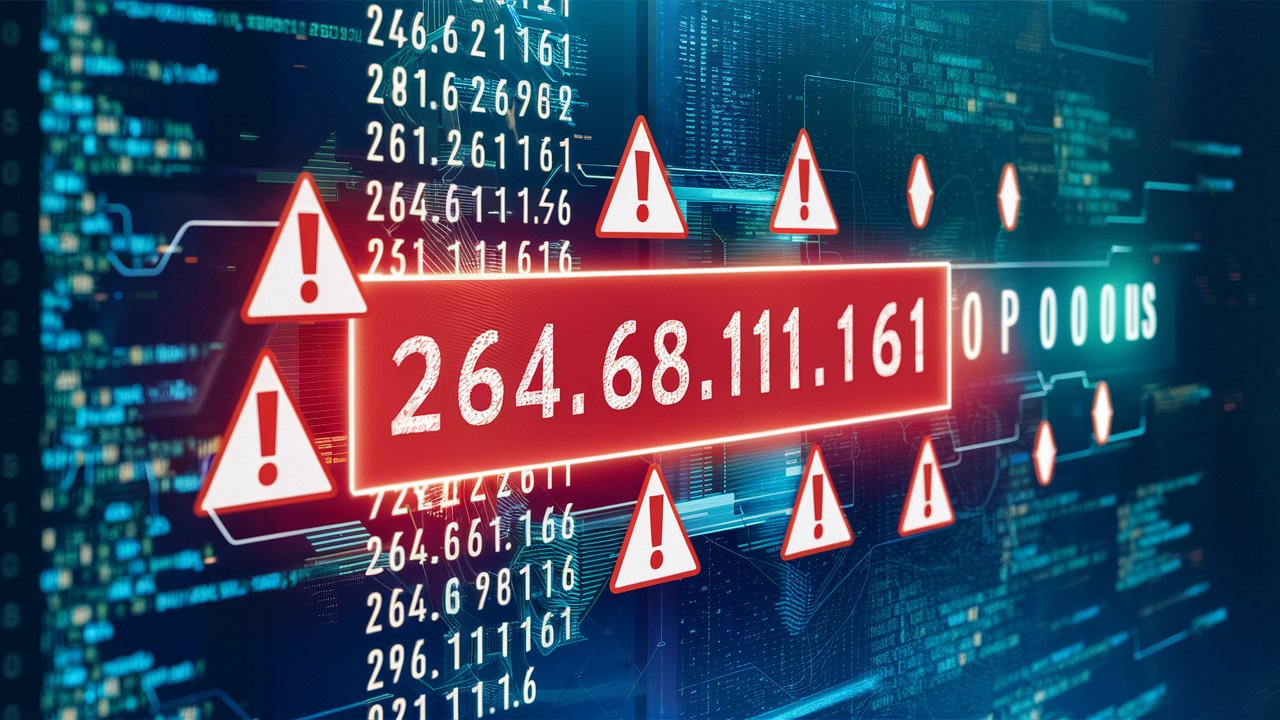Understanding 264.68.111.161: Why This IP Address Raises Red Flags

In the world of networking and cybersecurity, every numeric sequence can carry meaning—some innocuous, some deeply suspicious. Among them, 264.68.111.161 is a peculiar case: it looks like a typical IPv4 address, but it fails the validity test. In this article, we explain why 264.68.111.161 is considered invalid, explore the implications of encountering such an address in logs or emails, and examine the security, technical, and SEO issues it might signal. By the end, you’ll know what to do if you ever see this phantom IP.
What Makes 264.68.111.161 Invalid? – The Basics of IPv4 Ranges
At first glance, 264.68.111.161 appears to follow the IPv4 format: four decimal numbers (octets) separated by periods. But IPv4 has a strict requirement: each octet must be between 0 and 255. The number “264” exceeds that maximum, which immediately disqualifies this address from being valid.
-
IPv4 address format: A.B.C.D, where each A–D ∈ [0, 255].
-
Here, A = 264, which is outside the permitted range.
Thus, 264.68.111.161 is not a legitimate IPv4 address.
Because of this, any attempt to route traffic to or from 264.68.111.161 should fail by design, and it cannot be assigned as a real address in any network.
But the story does not end at invalidity—it’s precisely why this “non-address” is used in various shady contexts.
Why You Might Encounter 264.68.111.161 — And What It Signals
Seeing an invalid IP like 264.68.111.161 in network logs, email headers, or security reports is rarely a simple typo. Below are scenarios and motives behind its usage.
1. IP Spoofing and Decoys
Cyber attackers often spoof IP addresses to mask their true origin. By inserting a bogus address like 264.68.111.161, they create noise in the logs, complicating attribution, filtering, or detection by security systems.
2. Phishing and Spam Campaigns
In email headers or DNS entries, malicious actors may embed invalid IP addresses to make spam emails seem “exotic” or to trick spam filters. Because the address is invalid, mail systems may mishandle it, bypassing rules or generating confusion.
3. Log Pollution & Forensic Evasion
Malware or botnet agents may deliberately insert invalid IPs into logs or telemetry to confuse forensic analysts. If your log analyzer expects only valid IPv4 or IPv6 entries, an invalid line like 264.68.111.161 can evade detection paths or trigger error conditions.
4. Honeypots & Canary Traps
Security teams sometimes plant invalid IPs or unconventional addresses in their systems to act as “canaries.” If someone triggers an interaction with 264.68.111.161, it’s a strong sign that they’re probing or attacking, because regular traffic should never reference an invalid address.
5. Typographical or Configuration Errors
Not every occurrence is malicious—sometimes developers, system admins, or scripts misconfigure addresses, entering 264.68.111.161 unintentionally. However, repeated or deliberate inclusion should be treated with suspicion.
Technical Implications of Invalid IP Use
When an invalid IP like 264.68.111.161 shows up, it has ripple effects through your systems. Below are the technical consequences to watch for.
Routing and Failure to Resolve
Requests to invalid IPs will simply never route. DNS lookups won’t resolve, and any attempt to connect (TCP, UDP, ICMP) will fail. That means any system referencing 264.68.111.161 is broken or malicious.
Error Handling & System Crashes
Log parsers, routers, or firewalls that don’t validate inputs may crash or experience undefined behavior when encountering invalid addresses. Robust systems should validate IP syntax and reject malformed entries.
False Positives & Log Overload
Because this address is “impossible,” it may generate repeated errors or alerts, flooding log systems and masking real threats. Attackers rely on such distractions to hide real attack patterns.
Geolocation & Reputation Service Disruption
Reputation services, IP blacklists, or geo-databases may choke on invalid addresses. If your monitoring tools try to lookup 264.68.111.161 in a database, the invalid entry may return null, errors, or default fallback behavior—again aiding malicious evasion.

How to Detect & Respond When 264.68.111.161 Appears
If you find this address in your environment, here’s how to act methodically and decisively.
1. Flag and Isolate
As soon as 264.68.111.161 appears in logs, mark it for investigation. Don’t ignore it as a “typo.” Because it cannot be legitimate, it’s almost certainly a symptom.
2. Inspect Context
-
Where did it appear? Email header, DNS record, firewall log, application log?
-
Was it input or output?
-
What timestamp, associated source IP, or user account is involved?
Understanding context helps you decide: misconfiguration vs. attack.
3. Audit Surrounding Activity
Check preceding and following log lines, sessions tied to that user or host, and whether there are concurrent suspicious patterns (failed logins, anomalous traffic, encrypted exfiltration).
4. Validate IP Handling Routines
Review your IP parsing and validation modules. Ensure they reject octets > 255. Sanitize all external input for IP-type fields. Enforce strict formatting and rules in firewalls, proxies, web apps.
5. Block or Drop Carefully
Because 264.68.111.161 is invalid, your blocking rules may not even see it (firewalls may reject it first). But you can leverage pattern rules: drop any input with octet > 255 or logs referencing “264.” as a prefix. Use this defensively and monitor for collateral impact.
6. Use Canary Triggers
If you want to turn such events into actionable alerts, intentionally insert dummy invalid addresses (like 264.0.0.0) into your environment. Any real client referencing these is likely malicious scanning or probing.
Security & SEO Considerations of Fake IPs
While this is primarily a networking subject, the presence of fake or malformed IPs can also affect web security posture and SEO in subtle ways.
Web Server & Hosting Trust
Search engines may evaluate server trust, uptime, and consistency. If your logs or server responses are tainted with invalid address artifacts, security scanners reviewing your server (for pentesting or site audits) may mark your site as unstable or misconfigured.
Content & Analytics Skew
If an invalid IP appears in logs or analytics data (referrer logs, bot traffic logs), it can distort your traffic analysis. Unexpected entries may influence bounce rates, referrers, and bot-filtering heuristics—potentially impacting user metrics over time.
Reputation & Blacklists
If malicious spam or phishing emails reference 264.68.111.161 (posing as your server or domain), your domain or IP (if real) could be blacklisted inadvertently by mail filtering systems. You may need to issue DMARC, SPF, DKIM policies and monitor email reputation.
Why 264.68.111.161 Has Become a “Posterchild” for Invalid IPs
This particular numeric sequence has spread across cybersecurity blogs, forums, and articles as a canonical example of an invalid IP address. It’s symbolic—easy to remember, obviously out of range (264 > 255), and thus useful for demonstration.
Because of its frequent mention, encountering it in your own systems is more likely to draw attention and scrutiny. That makes it a useful test case or red flag in many technical write-ups. But its popularity also means attackers sometimes borrow it to create confusion or “signature poisoning.”
Conclusion
264.68.111.161 is more than a random string of numbers—it’s a red flag. While it fails the basic requirements of an IPv4 address and cannot route, its presence in logs, headers, or network traffic almost always signals probing, spoofing, misconfiguration, or malicious intent. Our advice: treat it seriously, validate aggressively, monitor context, and respond intentionally.


